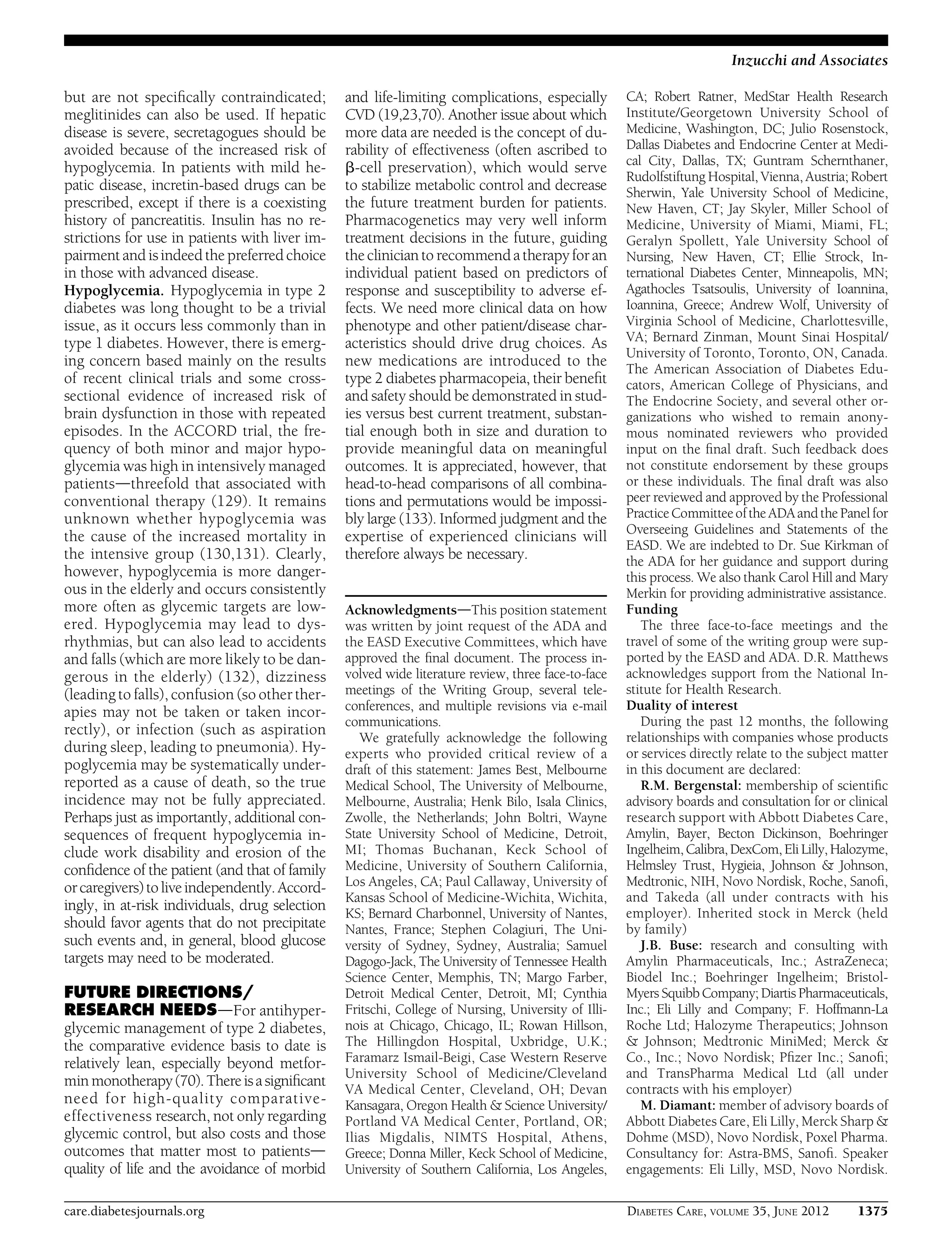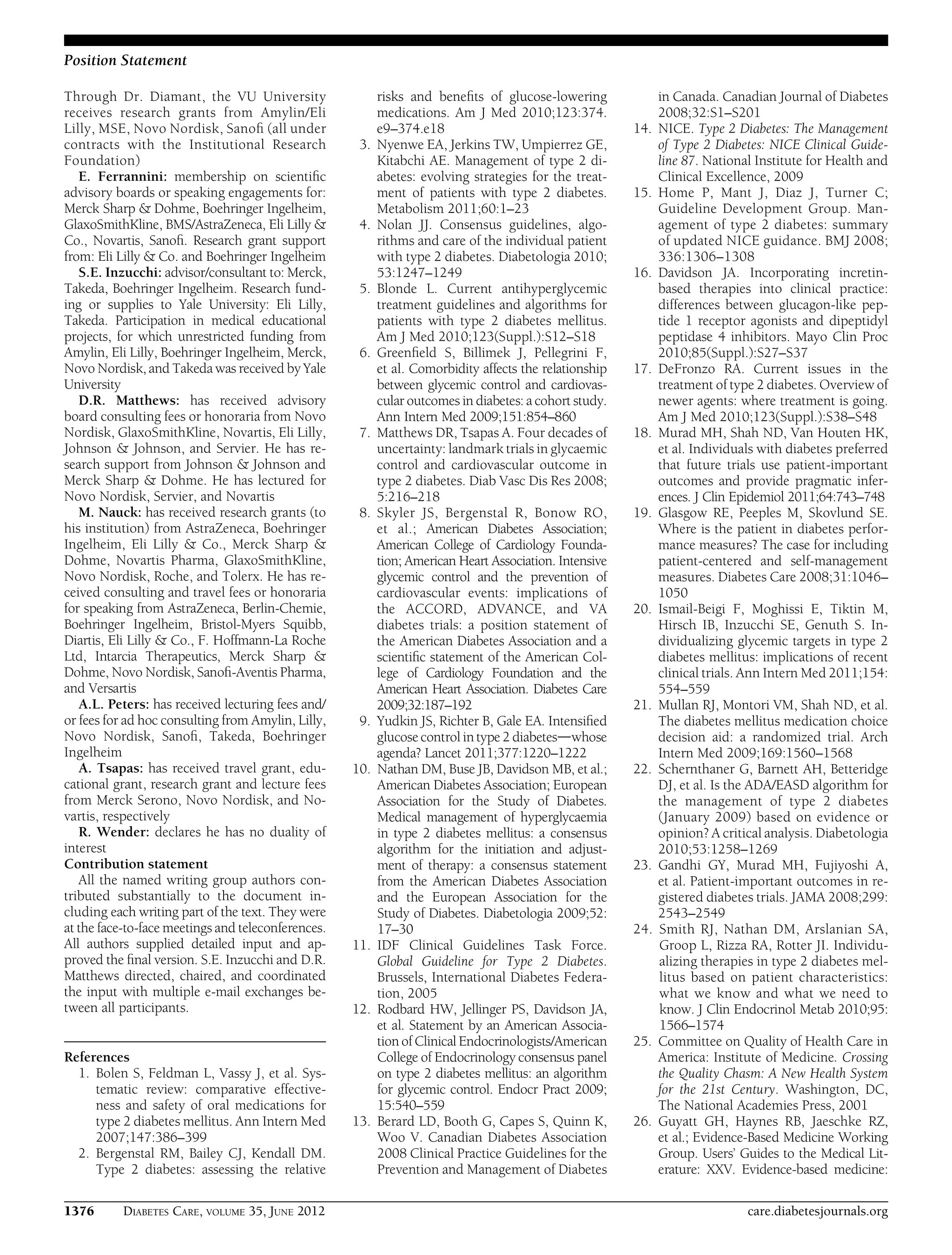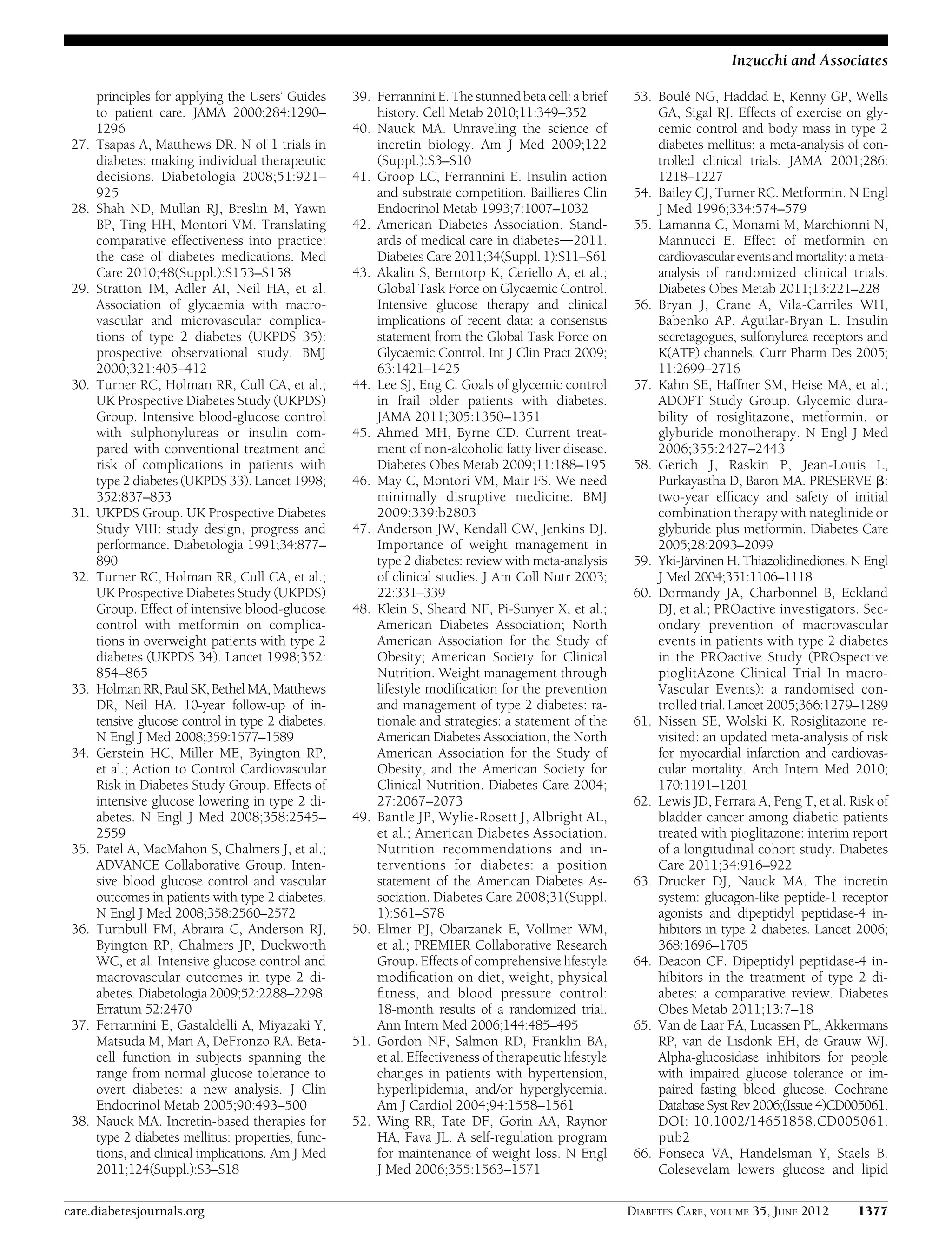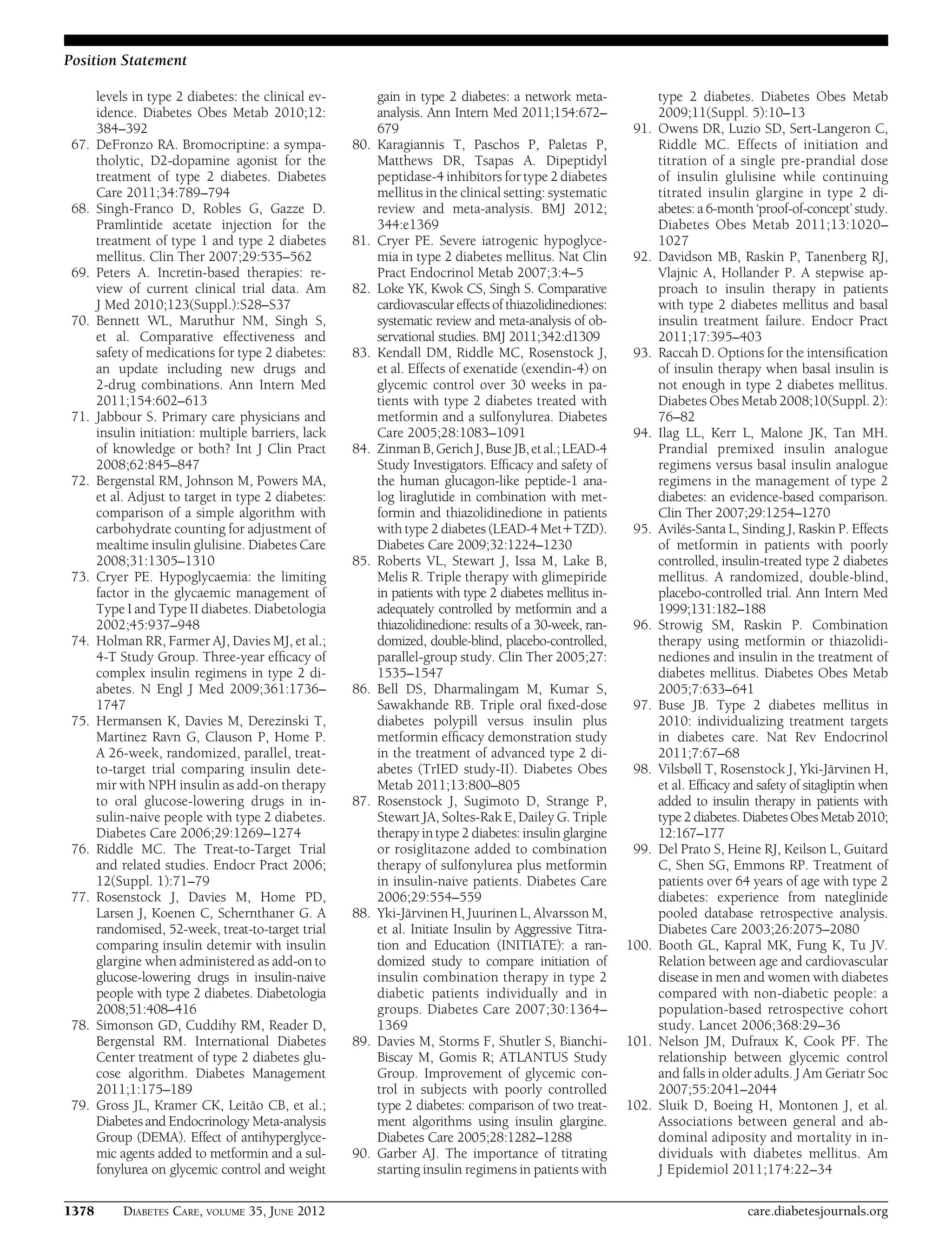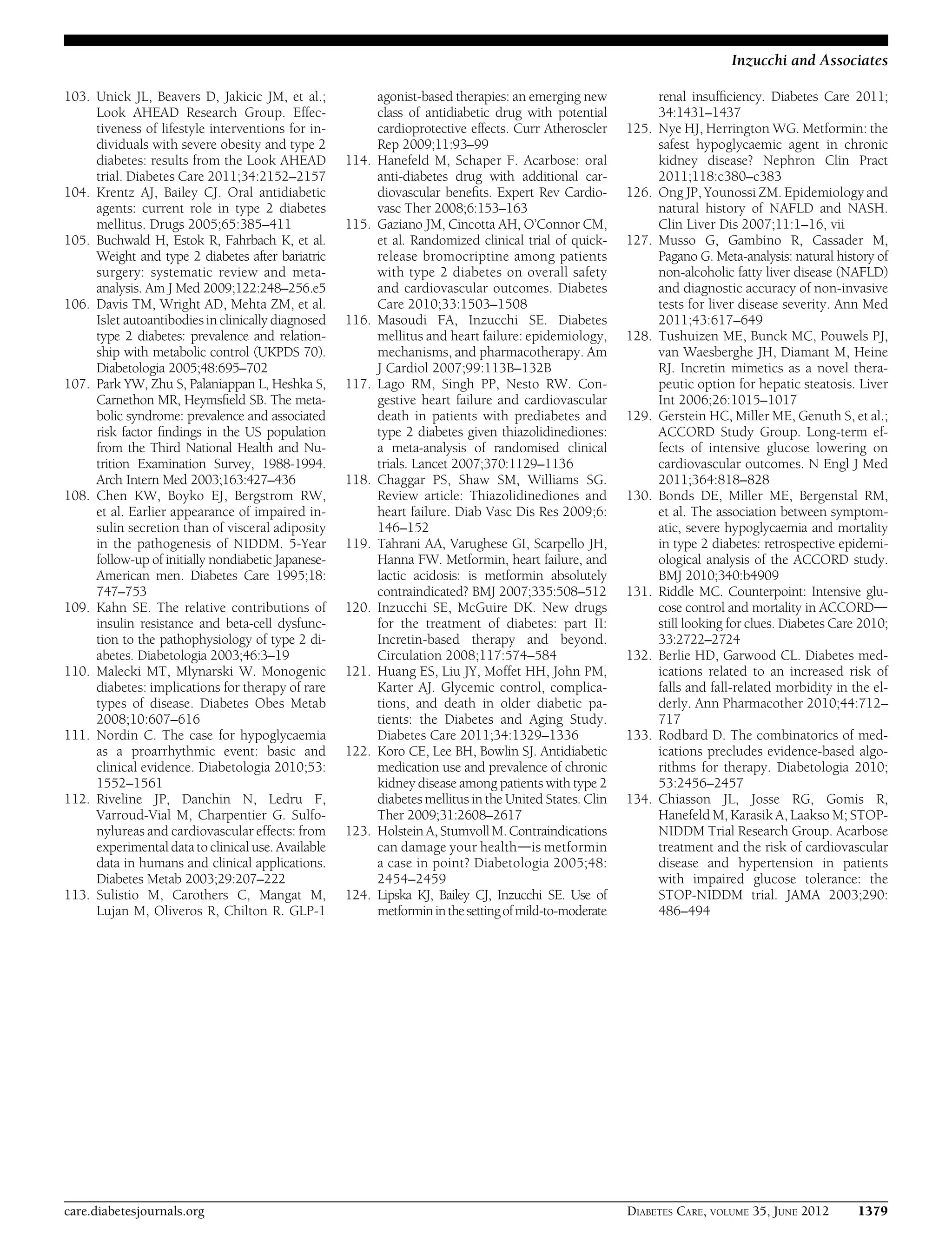This document provides a position statement from the American Diabetes Association and European Association for the Study of Diabetes on the management of hyperglycemia in type 2 diabetes. It recommends a patient-centered approach to treatment that considers individual patient needs, preferences, and tolerances. The statement reviews the evidence on glycemic control and outcomes, discusses the increasing complexity of treatment options, and emphasizes the importance of shared decision making between clinicians and patients.
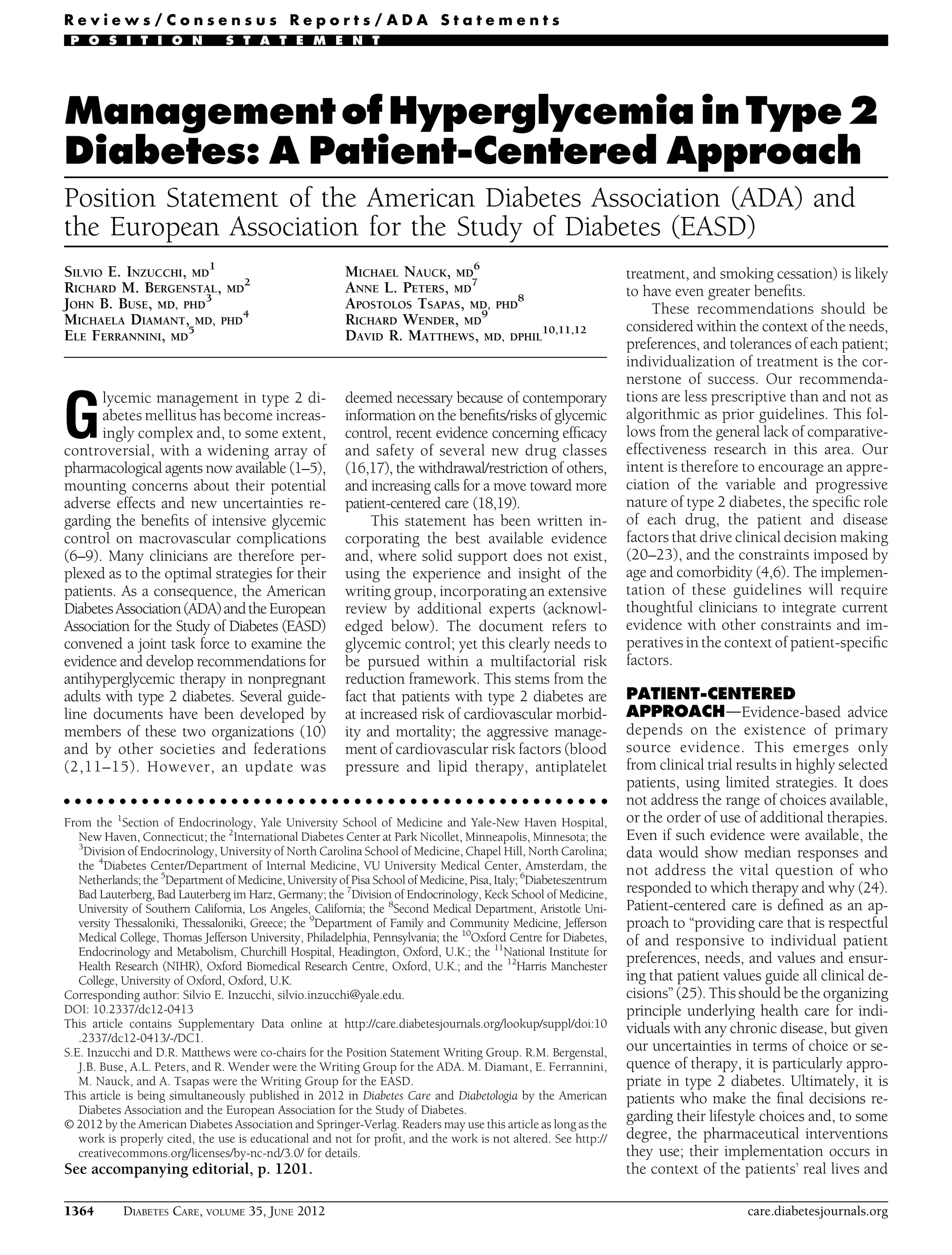
![relies on the consumption of resources
(both public and private).
Patient involvement in the medical
decision making constitutes one of the
core principles of evidence-based medi-
cine, which mandates the synthesis of best
available evidence from the literature with
the clinician’s expertise and patient’s own
inclinations(26).Duringtheclinicalencoun-
ter, the patient’s preferred level of involve-
ment should be gauged and therapeutic
choices explored, potentially with the uti-
lization of decision aids (21). In a shared
decision-making approach, clinician and
patient act as partners, mutually exchanging
information and deliberating on options, in
order toreach a consensusonthe therapeu-
tic course of action (27). There is good ev-
idence supporting the effectiveness of this
approach (28). Importantly, engaging pa-
tients in health care decisions may enhance
adherence to therapy.
BACKGROUND
Epidemiology and health care
impact
Both the prevalence and incidence of type 2
diabetes are increasing worldwide, particu-
larlyin developing countries, in conjunction
with increased obesity rates and westerni-
zation of lifestyle. The attendant economic
burden for health care systems is skyrocket-
ing, owing to the costs associated with treat-
ment and diabetes complications. Type 2
diabetes remains a leading cause of car-
diovascular disorders, blindness, end-stage
renal failure, amputations, and hospitaliza-
tions. It is also associated with increased risk
of cancer, serious psychiatric illness, cogni-
tive decline, chronic liver disease, acceler-
ated arthritis, and other disabling or deadly
conditions. Effective management strategies
are of obvious importance.
Relationship of glycemic control
to outcomes
It is well established that the risk of micro-
vascular and macrovascular complications
is related to glycemia, as measured by
HbA1c; this remains a major focus of ther-
apy (29). Prospective randomized trials
have documented reduced rates of micro-
vascular complications in type 2 diabetic
patients treated to lower glycemic targets.
In the UK Prospective Diabetes Study
(UKPDS) (30,31), patients with newly di-
agnosed type 2 diabetes were randomized
to two treatment policies. In the standard
group, lifestyle intervention was the main-
stay with pharmacological therapy used
only if hyperglycemia became severe. In the
more intensive treatment arm, patients were
randomly assigned to either a sulfonylurea
or insulin, with a subset of overweight
patients randomized to metformin. The
overall HbA1c achieved was 0.9% lower
in the intensive policy group compared
with the conventional policy arm (7.0%
vs. 7.9%). Associated with this difference in
glycemic control was a reduction in the risk
of microvascular complications (retinopa-
thy, nephropathy, neuropathy) with inten-
sive therapy. A trend toward reduced rates
of myocardial infarction in this group did
not reach statistical significance (30). By
contrast, substantially fewer metformin-
treated patients experienced myocardial
infarction, diabetes-related and all-cause
mortality (32), despite a mean HbA1c only
0.6% lower than the conventional policy
group. The UKPDS 10-year follow-up
demonstrated that the relative benefit of
having been in the intensive management
policy group was maintained over a de-
cade, resulting in the emergence of statisti-
cally significant benefits on cardiovascular
disease (CVD)end pointsandtotalmortality
in those initially assigned to sulfonylurea/
insulin, and persistence of CVD benefits
with metformin (33), in spite of the fact
that the mean HbA1c levels between the
groups converged soon after the ran-
domized component of the trial had
concluded.
In 2008, three shorter-term studies
[Action to Control Cardiovascular Risk in
Diabetes (ACCORD) (34), Action in Dia-
betes and Vascular Disease: Preterax and
Diamicron Modified-Release Controlled
Evaluation (ADVANCE) (35), Veterans Af-
fairs Diabetes Trial (VADT) (36)] reported
the effects of two levels of glycemic control
on cardiovascular end points in middle-
aged and older individuals with well-
established type 2 diabetes at high risk for
cardiovascular events. ACCORD and VADT
aimed for an HbA1c ,6.0% using complex
combinations of oral agents and insulin.
ADVANCE aimed for an HbA1c #6.5%
using a less intensive approach based on
the sulfonylurea gliclazide. None of the
trials demonstrated a statistically signif-
icant reduction in the primary combined
cardiovascular end points. Indeed, in
ACCORD, a 22% increase in total mortality
with intensive therapy was observed,
mainly driven by cardiovascular mortality.
An explanation for this finding has re-
mained elusive, although rates of hypogly-
cemia were threefold higher with intensive
treatment. It remains unclear, however, if
hypoglycemia was responsible for the ad-
verse outcomes, or if other factors, such as
more weight gain, or simply the greater
complexity of therapy, contributed. There
were suggestions in these trials that patients
without overt CVD, with shorter duration
of disease, and lower baseline HbA1c,
benefited from the more intensive strat-
egies. Modest improvements in some
microvascular end points in the studies
were likewise demonstrated. Finally, a
meta-analysis of cardiovascular out-
comes in these trials suggested that every
HbA1c reduction of ;1% may be associ-
ated with a 15% relative risk reduction in
nonfatal myocardial infarction, but
without benefits on stroke or all-cause
mortality (36).
Overview of the pathogenesis of
type 2 diabetes
Any rise in glycemia is the net result of
glucose influx exceeding glucose outflow
from the plasma compartment. In the fast-
ing state, hyperglycemia is directly related
to increased hepatic glucose production.
In the postprandial state, further glucose
excursions result from the combination
of insufficient suppression of this glucose
output and defective insulin stimulation
of glucose disposal in target tissues, mainly
skeletal muscle. Once the renal tubular
transport maximum for glucose is excee-
ded, glycosuria curbs, though does not
prevent, further hyperglycemia.
Abnormal islet cell function is a key
and requisite feature of type 2 diabetes. In
early disease stages, insulin production is
normal or increased in absolute terms,
but disproportionately low for the degree
of insulin sensitivity, which is typically
reduced. However, insulin kinetics, such
as the ability of the pancreatic b-cell to
release adequate hormone in phase with
rising glycemia, are profoundly compro-
mised. This functional islet incompetence
is the main quantitative determinant of
hyperglycemia (37) and progresses over
time. In addition, in type 2 diabetes, pan-
creatic a-cells hypersecrete glucagon, fur-
ther promoting hepatic glucose production
(38). Importantly, islet dysfunction is not
necessarily irreversible. Enhancing insulin
action relieves b-cell secretory burden, and
any intervention that improves glycemiad
from energy restriction to, most strikingly,
bariatric surgerydcan ameliorate b-cell
dysfunction to an extent (39). More re-
cently recognized abnormalities in the in-
cretin system (represented by the gut
hormones, glucagon-like peptide 1 [GLP-1],
and glucose-dependent insulinotropic
peptide [GIP]) are also found in type 2
diabetes, but it remains unclear whether
care.diabetesjournals.org DIABETES CARE, VOLUME 35, JUNE 2012 1365
Inzucchi and Associates](https://image.slidesharecdn.com/hyperglycemiaindmada2012-151031230308-lva1-app6891/75/Hyperglycemia-in-dm-ada-2012-2-2048.jpg)
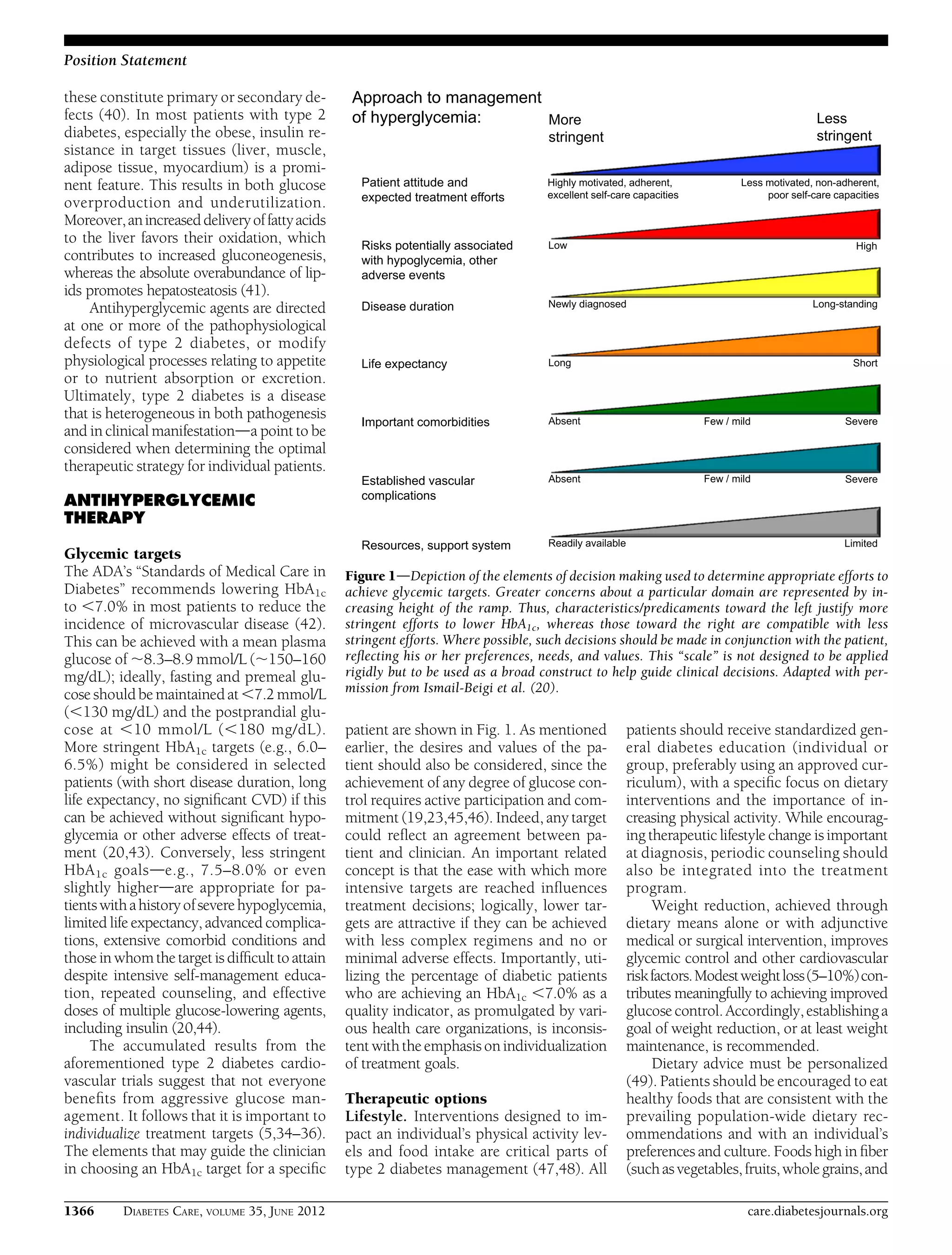


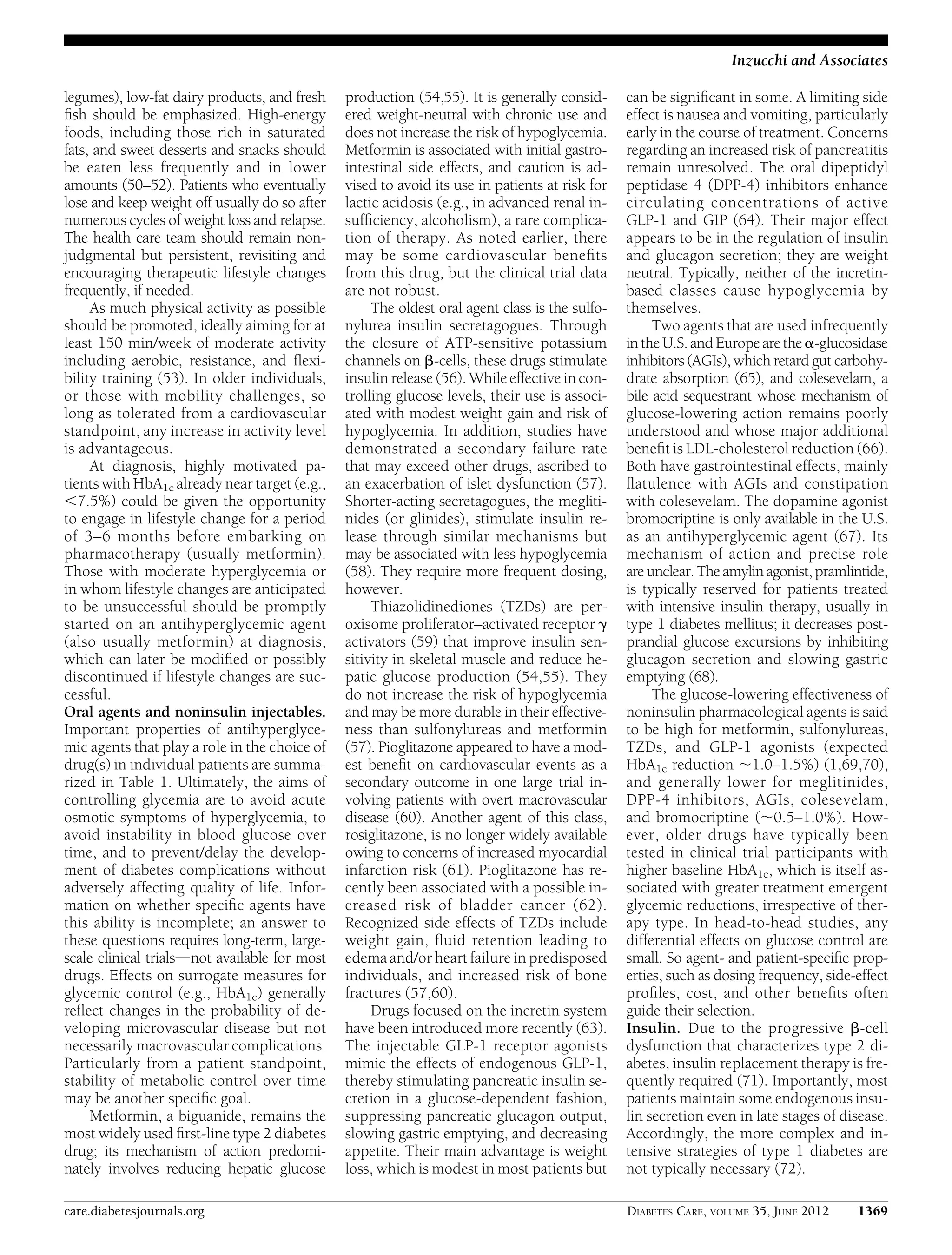
![Ideally, the principle of insulin use is
the creation of as normal a glycemic profile
as possible without unacceptable weight
gain or hypoglycemia (73). As initial ther-
apy, unless the patient is markedly hyper-
glycemic and/or symptomatic, a “basal”
insulin alone is typically added (74). Basal
insulin provides relatively uniform insulin
coverage throughout the day and night,
mainly to control blood glucose by sup-
pressing hepatic glucose production in
between meals and during sleep. Either
intermediate-acting (neutral protamine
Hagedorn [NPH]) or long-acting (insulin
glargine [A21Gly,B31Arg,B32Arg hu-
man insulin] or insulin detemir [B29Lys
(´-tetradecanoyl),desB30 human insulin])
formulations may be used. The latter two
are associated with modestly less overnight
hypoglycemia (insulin glargine, insulin de-
temir) than NPH and possibly slightly less
weight gain (insulin detemir), but are
more expensive (75,76). Of note, the dos-
ing ofthesebasalinsulin analogsmaydiffer,
with most comparative trials showing a
higher average unit requirement with insu-
lin detemir (77).
Although the majority of patients
with type 2 diabetes requiring insulin
therapy can be successfully treated with
basal insulin alone, some, because of pro-
gressive diminution in their insulin secre-
tory capacity, will require prandial insulin
therapy with shorter-acting insulins. This
is typically provided in the form of the
rapid insulin analogs, insulin lispro
(B28Lys,B29Pro human insulin), insulin
aspart (B28Asp human insulin), or insulin
glulisine (B3Lys,B29Glu human insulin),
which may be dosed just before the meal.
They result in better postprandial glucose
control than the less costly human regular
insulin, whose pharmacokinetic profile
makes it less attractive in this setting.
Ideally, an insulin treatment program
should be designed specifically for an in-
dividual patient, to match the supply of
insulin to his or her dietary/exercise hab-
its and prevailing glucose trends, as revealed
throughself-monitoring.Anticipatedglucose-
lowering effects should be balanced with
the convenience of the regimen, in the
context of an individual’s specific therapy
goals (Fig. 1).
Proper patient education regarding
glucose monitoring, insulin injection
technique, insulin storage, recognition/
treatment of hypoglycemia, and “sick
day” rules is imperative. Where available,
certified diabetes educators can be in-
valuable in guiding the patient through
this process.
Implementation strategies
Initial drug therapy. It is generally
agreed that metformin, if not contraindi-
cated and if tolerated, is the preferred and
most cost-effective first agent (42) (Fig. 2
and Supplementary Figs.). It is initiated at,
or soon after, diagnosis, especially in pa-
tients in whom lifestyle intervention alone
has not achieved, or is unlikely to achieve,
HbA1c goals. Because of frequent gastroin-
testinal side effects, it should be started at a
low dose with gradual titration. Patients
with a high baseline HbA1c (e.g., $9.0%)
have a low probability of achieving a near-
normal target with monotherapy. It may
therefore be justified to start directly
with a combination of two noninsulin
agents or with insulin itself in this circum-
stance (78). If a patient presents with sig-
nificant hyperglycemic symptoms and/or
has dramatically elevated plasma glucose
concentrations (e.g., .16.7–19.4 mmol/L
[.300–350 mg/dL]) or HbA1c (e.g.,
$10.0–12.0%), insulin therapy should be
strongly considered from the outset. Such
treatment is mandatory when catabolic
features are exhibited or, of course, if
ketonuria is demonstrated, the latter re-
flecting profound insulin deficiency. Im-
portantly, unless there is evidence of type 1
diabetes, once symptoms are relieved,
glucotoxicity resolved, and the metabolic
state stabilized, it may be possible to taper
insulin partially or entirely, transferring to
noninsulin antihyperglycemic agents, per-
haps in combination.
If metformin cannot be used, another
oral agent could be chosen, such as a
sulfonylurea/glinide, pioglitazone, or a
DPP-4 inhibitor; in occasional cases where
weight loss is seen as an essential aspect of
therapy, initial treatment with a GLP-1
receptor agonist might be useful. Where
available, less commonly used drugs (AGIs,
colesevelam, bromocriptine) might also be
considered in selected patients, but their
modest glycemic effects and side-effect
profiles make them less attractive candi-
dates. Specific patient preferences, char-
acteristics, susceptibilities to side effects,
potential for weight gain and hypoglycemia
should play a major role in drug selection
(20,21). (See Supplementary Figs. for ad-
aptations of Fig. 2 that address specific
patient scenarios.)
Advancing to dual combination therapy.
Figure 2 (and Supplementary Figs.) also
depicts potential sequences of escalating
glucose-lowering therapy beyond met-
formin. If monotherapy alone does not
achieve/maintain an HbA1c target over
;3 months, the next step would be to
add a second oral agent, a GLP-1 recep-
tor agonist, or basal insulin (5,10). No-
tably, the higher the HbA1c, the more
likely insulin will be required. On average,
any second agent is typically associated
with an approximate further reduction in
HbA1c of ;1% (70,79). If no clinically
meaningful glycemic reduction (i.e., “non-
responder”) is demonstrated, then, adher-
ence having been investigated, that agent
should be discontinued, and another
with a different mechanism of action
substituted. With a distinct paucity of
long-term comparative-effectiveness trials
available, uniform recommendations on
the best agent to be combined with metfor-
min cannot be made (80).Thus, advantages
and disadvantages of specific drugs for each
patient should be considered (Table 1).
Some antihyperglycemic medications
lead to weight gain. This may be associ-
ated with worsening markers of insulin
resistance and cardiovascular risk. One
exception may be TZDs (57); weight gain
associated with this class occurs in asso-
ciation with decreased insulin resistance.
Although there is no uniform evidence that
increases in weight in the range observed
with certain therapies translate into a sub-
stantially increased cardiovascular risk, it
remains important to avoid unnecessary
KEY POINTS
c Glycemic targets and glucose-lowering
therapies must be individualized.
c Diet, exercise, and education remain
the foundation of any type 2 diabetes
treatment program.
c Unless there are prevalent contra-
indications, metformin is the op-
timal first-line drug.
c After metformin, there are limited
data to guide us. Combination
therapy with an additional 1–2 oral
or injectable agents is reasonable,
aiming to minimize side effects
where possible.
c Ultimately, many patients will require
insulin therapy alone or in com-
bination with other agents to
maintain glucose control.
c All treatment decisions, where possi-
ble, should be made in conjunction
with the patient, focusing on his/her
preferences, needs, and values.
c Comprehensive cardiovascular risk
reduction must be a major focus of
therapy.
1370 DIABETES CARE, VOLUME 35, JUNE 2012 care.diabetesjournals.org
Position Statement](https://image.slidesharecdn.com/hyperglycemiaindmada2012-151031230308-lva1-app6891/75/Hyperglycemia-in-dm-ada-2012-7-2048.jpg)
![weight gain by optimal medication selec-
tion and dose titration.
For all medications, consideration
should also be given to overall tolerability.
Even occasional hypoglycemia may be
devastating, if severe, or merely irritating,
if mild (81). Gastrointestinal side effects
may be tolerated by some, but not others.
Fluid retention may pose a clinical or
merely an aesthetic problem (82). The
risk of bone fractures may be a specific con-
cern in postmenopausal women (57).
It must be acknowledged that costs
are a critical issue driving the selection of
glucose-lowering agents in many environ-
ments. For resource-limited settings, less
expensive agents should be chosen. How-
ever, due consideration should be also
given to side effects and any necessary
monitoring, with their own cost impli-
cations. Moreover, prevention of morbid
Figure 2dAntihyperglycemic therapy in type 2 diabetes: general recommendations. Moving from the top to the bottom of the figure, potential
sequences of antihyperglycemic therapy. In most patients, begin with lifestyle changes; metformin monotherapy is added at, or soon after, diagnosis
(unless there are explicit contraindications). If the HbA1c target is not achieved after ;3 months, consider one of the five treatment options combined
with metformin: a sulfonylurea, TZD, DPP-4 inhibitor, GLP-1 receptor agonist, or basal insulin. (The order in the chart is determined by historical
introduction and route of administration and is not meant to denote any specific preference.) Choice is based on patient and drug characteristics, with
the over-riding goal of improving glycemic control while minimizing side effects. Shared decision making with the patient may help in the selection of
therapeutic options. The figure displays drugs commonly used both in the U.S. and/or Europe. Rapid-acting secretagogues (meglitinides) may be
used in place of sulfonylureas. Other drugs not shown (a-glucosidase inhibitors, colesevelam, dopamine agonists, pramlintide) may be used where
available in selected patients but have modest efficacy and/or limiting side effects. In patients intolerant of, or with contraindications for, metformin,
select initial drug from other classes depicted and proceed accordingly. In this circumstance, while published trials are generally lacking, it is
reasonable to consider three-drug combinations other than metformin. Insulin is likely to be more effective than most other agents as a third-line
therapy, especially when HbA1c is very high (e.g., $9.0%). The therapeutic regimen should include some basal insulin before moving to more
complex insulin strategies (Fig. 3). Dashed arrow line on the left-hand side of the figure denotes the option of a more rapid progression from a two-
drug combination directly to multiple daily insulin doses, in those patients with severe hyperglycemia (e.g., HbA1c $10.0–12.0%). DPP-4-i, DPP-4
inhibitor; Fx’s, bone fractures; GI, gastrointestinal; GLP-1-RA, GLP-1 receptor agonist; HF, heart failure; SU, sulfonylurea. a
Consider beginning at this
stage in patients with very high HbA1c (e.g., $9%). b
Consider rapid-acting, nonsulfonylurea secretagogues (meglitinides) in patients with irregular
meal schedules or who develop late postprandial hypoglycemia on sulfonylureas. c
See Table 1 for additional potential adverse effects and risks, under
“Disadvantages.” d
Usually a basal insulin (NPH, glargine, detemir) in combination with noninsulin agents. e
Certain noninsulin agents may be
continued with insulin (see text). Refer to Fig. 3 for details on regimens. Consider beginning at this stage if patient presents with severe hyperglycemia
($16.7–19.4 mmol/L [$300–350 mg/dL]; HbA1c $10.0–12.0%) with or without catabolic features (weight loss, ketosis, etc.).
care.diabetesjournals.org DIABETES CARE, VOLUME 35, JUNE 2012 1371
Inzucchi and Associates](https://image.slidesharecdn.com/hyperglycemiaindmada2012-151031230308-lva1-app6891/75/Hyperglycemia-in-dm-ada-2012-8-2048.jpg)
![long-term complications will likely reduce
long-termexpensesattributedtothedisease.
Advancing to triple combination ther-
apy. Some studies have shown advantages
of adding a third noninsulin agent to a
two-drug combination that is not yet or
no longer achieving the glycemic target
(83–86). Not surprisingly, however, at
this juncture, the most robust response
will usually be with insulin. Indeed, since
diabetes is associated with progressive
b-cell loss, many patients, especially those
with long-standing disease, will eventually
need to be transitioned to insulin, which
should be favored in circumstances where
the degree of hyperglycemia (e.g., $8.5%)
makes it unlikely that another drug will be
of sufficient benefit (87). If triple combina-
tion therapy exclusive of insulin is tried, the
patient should be monitored closely, with
the approach promptly reconsidered if it
proves to be unsuccessful. Many months
of uncontrolled hyperglycemia should
specifically be avoided.
In using triple combinations the es-
sential consideration is obviously to use
agents with complementary mechanisms
of action (Fig. 2 and Supplementary Figs.).
Increasing the number of drugs heightens
the potential for side effects and drug–drug
interactions, raises costs, and negatively im-
pacts patient adherence. The rationale, ben-
efits,and sideeffectsof each new medication
should be discussed with the patient. The
clinical characteristics of patients more or
less likely to respond to specific combina-
tions are, unfortunately, not well defined.
Transitions to and titrations of insulin.
Most patients express reluctance to be-
ginning injectable therapy, but, if the
practitioner feels that such a transition is
important, encouragement and education
can usually overcome such reticence. In-
sulin is typically begun at a low dose (e.g.,
0.1–0.2 U kg21
day21
), although larger
amounts (0.3–0.4 U kg21
day21
) are rea-
sonable in the more severely hyperglyce-
mic. The most convenient strategy is
with a single injection of a basal insulin,
with the timing of administration depen-
dent on the patient’s schedule and overall
glucose profile (Fig. 3).
Although extensive dosing instruc-
tions for insulin are beyond the scope of
this statement, most patients can be taught
to uptitrate their own insulin dose based
on several algorithms, each essentially in-
volving the addition of a smalldose increase
if hyperglycemia persists (74,76,88). For
example, the addition of 1–2 units (or, in
those already on higher doses, increments
of 5–10%) to the daily dose once or twice
weeklyifthe fasting glucose levelsare above
the preagreed target is a reasonable ap-
proach (89). As the target is neared, dosage
adjustments should be more modest and
occur less frequently. Downward adjust-
ment is advisable if any hypoglycemia oc-
curs. During self-titration, frequent contact
(telephone, e-mail) with the clinician may
be necessary. Practitioners themselves can,
of course, also titrate basal insulin, but this
would involve more intensive contact with
the patient than typically available in rou-
tine clinical practice. Daily self-monitoring
of blood glucose is of obvious importance
during this phase. After the insulin dose is
stabilized, the frequency of monitoring
should be reviewed (90).
Consideration should be given to the
addition of prandial or mealtime insulin
coverage when significant postprandial
glucose excursions (e.g., to .10.0 mmol/L
[.180 mg/dL]) occur. This is suggested
when the fasting glucose is at target but
the HbA1c remains above goal after 3–6
months of basal insulin titration (91). The
same would apply if large drops in glucose
occur during overnight hours or in be-
tween meals, as the basal insulin dose is
increased. In this scenario, the basal insulin
dose would obviously need to be simulta-
neously decreased as prandial insulin is ini-
tiated. Although basal insulin is titrated
primarily against the fasting glucose, gen-
erally irrespective of the total dose, practi-
tioners should be aware that the need for
prandialinsulintherapywillbecomelikelythe
more the daily dose exceeds 0.5 U kg21
day21
, especially as it approaches 1 U kg21
day21
. The aim with mealtime insulin is to
blunt postprandial glycemic excursions,
Figure 3dSequential insulin strategies in type 2 diabetes. Basal insulin alone is usually the
optimal initial regimen, beginning at 0.1–0.2 units/kg body weight, depending on the degree of
hyperglycemia. It is usually prescribed in conjunction with one to two noninsulin agents. In
patients willing to take more than one injection and who have higher HbA1c levels ($9.0%), twice-
daily premixed insulin or a more advanced basal plus mealtime insulin regimen could also be
considered (curved dashed arrow lines). When basal insulin has been titrated to an acceptable
fasting glucose but HbA1c remains above target, consider proceeding to basal plus mealtime in-
sulin, consisting of one to three injections of rapid-acting analogs (see text for details). A less
studied alternativedprogression from basal insulin to a twice-daily premixed insulindcould be
also considered (straight dashed arrow line); if this is unsuccessful, move to basal plus mealtime
insulin. The figure describes the number of injections required at each stage, together with the relative
complexity and flexibility. Once a strategy is initiated, titration of the insulin dose is important, with
dose adjustments made based on the prevailing glucose levels as reported by the patient. Noninsulin
agents may be continued, although insulin secretagogues (sulfonylureas, meglitinides) are typically
stopped once more complex regimens beyond basal insulin are utilized. Comprehensive education
regarding self-monitoring of blood glucose, diet, exercise, and the avoidance of, and response to,
hypoglycemia are critical in any patient on insulin therapy. Mod., moderate.
1372 DIABETES CARE, VOLUME 35, JUNE 2012 care.diabetesjournals.org
Position Statement](https://image.slidesharecdn.com/hyperglycemiaindmada2012-151031230308-lva1-app6891/75/Hyperglycemia-in-dm-ada-2012-9-2048.jpg)

![these procedures. The majority of patients
are able to stop some, or even all, of their
antihyperglycemic medications, although
the durability of this effect is not known
(105).
In lean patients, consideration should
be given to the possibility of latent autoim-
mune diabetes in adults (LADA), a slowly
progressive form of type 1 diabetes. These
individuals, while presenting with mild
hyperglycemia, often responsive to oral
agents, eventually develop more severe
hyperglycemia and require intensive insu-
lin regimens (106).Measuring titresofislet-
associated autoantibodies (e.g., anti-GAD)
may aid their identification, encouraging a
more rapid transition to insulin therapy.
Sex/racial/ethnic/genetic differences
While certain racial/ethnic features that
increase the risk of diabetes are well recog-
nized [greater insulin resistance in Latinos
(107), more b-cell dysfunction in East
Asians (108)], using this information to
craft optimal therapeutic strategies is in its
infancy. This is not surprising given the
polygenic inheritance pattern of the dis-
ease. Indeed, while matching a drug’s
mechanism of action to the underlying
causes of hyperglycemia in a specific patient
seems logical, there are few data that com-
pare strategies based on this approach
(109). There are few exceptions, mainly
involving diabetes monogenic variants of-
ten confused with type 2 diabetes, such as
maturity-onset diabetes of the young
(MODY), several forms of which respond
preferentially to sulfonylureas (110).
While there are no prominent sex differ-
ences in the response to various antihyper-
glycemic drugs, certain side effects (e.g.,
bone loss with TZDs) may be of greater
concern in women.
Comorbidities
Coronary artery disease. Given the fre-
quency with which type 2 diabetic patients
develop atherosclerosis, optimal manage-
mentstrategies for those with orathighrisk
for coronary artery disease (CAD) are
important. Since hypoglycemia may ex-
acerbate myocardial ischemia and may
cause dysrhythmias (111), it follows that
medications that predispose patients to
this adverse effect should be avoided, if
possible. If they are required, however, to
achieve glycemic targets, patients should
be educated to minimize risk. Because of
possible effects on potassium channels in
the heart, certain sulfonylureas have been
proposed to aggravate myocardial ischemia
througheffectsonischemicpreconditioning
(112), but the actual clinical relevance of this
remains unproven. Metformin may have
some cardiovascular benefits and would
appear to be a useful drug in the setting
of CAD, barring prevalent contraindica-
tions (32). In a single study, pioglitazone
was shown to reduce modestly major ad-
verse cardiovascular events in patients
with established macrovascular disease.
It may therefore also be considered, unless
heart failure is present (60). In very pre-
liminary reports, therapy with GLP-1 re-
ceptor agonists and DPP-4 inhibitors has
been associated with improvement in ei-
ther cardiovascular risk or risk factors, but
there are no long-term data regarding clin-
ical outcomes (113). There are very limited
data suggesting that AGIs (114) and bromo-
criptine (115) may reduce cardiovascular
events.
Heart failure. With an aging population
and recent decreases in mortality after
myocardial infarction, the diabetic patient
with progressive heart failure is an in-
creasingly common scenario (116). This
population presents unique challenges
given their polypharmacy, frequent hos-
pitalizations, and contraindications to
various agents. TZDs should be avoided
(117,118). Metformin, previously contra-
indicated in heart failure, can now be used
if the ventricular dysfunction is not se-
vere, if patient’s cardiovascular status is
stable, and if renal function is normal
(119). As mentioned, cardiovascular ef-
fects of incretin-based therapies, includ-
ing those on ventricular function, are
currently under investigation (120).
Chronic kidney disease. Kidney disease
is highly prevalent in type 2 diabetes, and
moderate to severe renal functional im-
pairment (eGFR ,60 mL/min) occurs in
approximately 20–30% of patients
(121,122). The individual with progres-
sive renal dysfunction is at increased risk
for hypoglycemia, which is multifactorial.
Insulin and, to some degree, the incretin
hormones are eliminated more slowly, as
are antihyperglycemic drugs with renal
excretion. Thus, dose reduction may be
necessary, contraindications need to be
observed, and consequences (hypoglyce-
mia, fluid retention, etc.) require careful
evaluation.
Current U.S. prescribing guidelines
warn against the use of metformin in
patients with a serum creatinine $133
mmol/L ($1.5 mg/dL) in men or 124
mmol/L ($1.4 mg/dL) in women. Metfor-
min is eliminated renally, and cases of lactic
acidosis have been described in patients
with renal failure (123). There is an
ongoing debate, however, as to whether
these thresholds are too restrictive and
that those with mild–moderate renal im-
pairment would gain more benefit than
harm from using metformin (124,125). In
the U.K., the National Institute for Health
and Clinical Excellence (NICE) guidelines
are less proscriptive and more evidence-
based than those in the U.S., generally al-
lowing use down to a GFR of 30 mL/min,
with dose reduction advised at 45 mL/min
(14). Given the current widespread report-
ing of estimated GFR, these guidelines
appear very reasonable.
Most insulin secretagogues undergo
significant renal clearance (exceptions in-
clude repaglinide and nateglinide) and
the risk of hypoglycemia is therefore
higher in patients with chronic kidney
disease (CKD). For most of these agents,
extreme caution is imperative at more severe
degrees of renal dysfunction. Glyburide
(known as glibenclamide in Europe),
which has a prolonged duration of
action and active metabolites, should
be specifically avoided in this group.
Pioglitazone is not eliminated renally, and
therefore there are no restrictions for use
in CKD. Fluid retention may be a concern,
however. Among the DPP-4 inhibitors,
sitagliptin, vildagliptin, and saxagliptin
share prominent renal elimination. In the
face of advanced CKD, dose reduction is
necessary. One exception is linagliptin,
which is predominantly eliminated enter-
ohepatically. For the GLP-1 receptor ago-
nists exenatide is contraindicated in stage
4–5 CKD (GFR ,30 mL/min) as it is re-
nally eliminated; the safety of liraglutide is
not established in CKD though pharmaco-
kinetic studies suggest that drug levels are
unaffected as it does not require renal func-
tion for clearance.
More severe renal functional impair-
ment is associated with slower elimina-
tion of all insulins. Thus doses need to be
titrated carefully, with some awareness
for the potential for more prolonged
activity profiles.
Liver dysfunction. Individuals with type
2 diabetes frequently have hepatosteatosis
as well as other types of liver disease
(126). There is preliminary evidence that
patients with fatty liver may benefit from
treatment with pioglitazone (45,127,128).
It should not be used in an individual with
active liver disease or an alanine transami-
nase level above 2.5 times the upper limit of
normal. In those with steatosis but milder
liver test abnormalities, this insulin sensi-
tizer may be advantageous. Sulfonylureas
can rarely cause abnormalities in liver tests
1374 DIABETES CARE, VOLUME 35, JUNE 2012 care.diabetesjournals.org
Position Statement](https://image.slidesharecdn.com/hyperglycemiaindmada2012-151031230308-lva1-app6891/75/Hyperglycemia-in-dm-ada-2012-11-2048.jpg)
